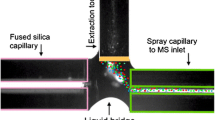Summary
The electron capture detector (ECD) has become a indispensable and widely used tool for the detection of halogenated compounds in gas chromatography. The ECD is successfully used for routine analysis particularly in the field of environmental survey, residue determination in the food and agriculture chemistry and even more so in clinical chemistry. However, its application with high resolution glass capillary columns revealed a substantial drawback of existing ECD's, primarily the relatively large internal detector volume. The micro ECD described, with its very small cell volume (∼140 mm3), particularly designed for use with high resolution capillary columns, minimizes drastically the loss of separation efficiency since diffusion effects are negligible. The micro ECD permits the use of splitless or split injection techniques, as well as temperature programmed analysis to optimize sample separation. Very stable baseline and low noise conditions lower the detection limits considerably (∼2 pg Lindane full scale). The micro ECD can be operated either with direct current, pulsed frequency or constant current modes. Examples demonstrating the capabilities of this detector include the detection of halogenated organic volatiles in water at subnanogram levels, the determination of PCB's and pesticide residues in food as well as selected analysis in clinical chemistry, such as bile acids and amino acids in body fluids.
Similar content being viewed by others
Literature
J. E. Lovelock, J. Chromatogr.I, 35 (1958).
J. E. Lovelock, Nature (London)182, 1460 (1958).
E. D. Pellizzari, J. Chromatogr.92, 299–308 (1974).
S. R. Shoemake, D. C. Fenimore andA. Zlatkis, J. Gas Chrom.3, 285 (1965).
P. G. Simmonds, D. C. Fenimore, B. C. Pettit, J. E. Lovelock andA. Zlatkis, Anal. Chem.39, 1428 (1967).
G. R. Shoemake, J. E. Lovelock andA. Zlatkis, J. Chromatogr.12, 314 (1963).
C. H. Hartmann, Anal. Chem.45, 733 (1973).
W. A. Aue andS. Kapila, J. Chrom. Sci.5, 255 (1973).
R. J. Maggs, P. L. Joynes, A. J. Davies andJ. E. Lovelock, Anal. Chem.43, 1966 (1971).
J. E. Lovelock, J. Chromatogr.99, 3 (1974).
J. J. Sullivan andC. A. Burgett, Chromatographia8, 176 (1975).
K. Grob andG. Grob, Chromatographia5, 3 (1972).
F. Zürcher andW. Giger, vom Wasser47, 37–55 (1976).
K. Grob andF. Zürcher, J. Chromatogr.117, 285 (1970).
K. Grob, Chromatographia,8, 423 (1975).
M. Reinhard, Ph. D. thesis, No. 5719, ETH Zurich, 1977.
W. Giger, M. Reinhard, C. Schaffner andF. Zürcher inL. H. Keith, Ed., Identification and Analysis of Organic Pollutants in Water, Ann Harbor Publishers, 1976.
F. Zürcher, M. Reinhard, andW. Giger, private communication.
H. R. Buser, Anal. Chem.48, 1553 (1976).
I. Makino andJ. Sjövall, Anal. Lett.5, 341 (1972).
C. W. Gehrke andH. Takeda, J. Chromatogr.76, 63 (1973).
R. W. Zumwalt, K. Kuo andC. W. Gehrke, J. Chromatogr.57, 193 (1971).
Author information
Authors and Affiliations
Rights and permissions
About this article
Cite this article
Brechbühler, B., Gay, L. & Jaeger, H. A micro electron capture detector for temperature programmed analysis with capillary columns for a wide range of applications. Chromatographia 10, 478–486 (1977). https://doi.org/10.1007/BF02257363
Issue Date:
DOI: https://doi.org/10.1007/BF02257363




